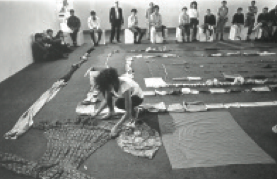María Teresa Hincapié
Life as a perfomance. Miami
Francine Birbragher’s curatorial work for the exhibition In body and Soul: The Performance Art of María Teresa Hincapié, featured at the Frost Art Museum, proves to what extent the work of this Colombian artist who had a short life (she was born in the city of Armenia in 1956 and passed away in Bogota in 2008) opened an indelible path for performance in the continent: a complete fusion between the artwork and everyday life, transformed into a sacralized space from which she did not only build a spiri- tual universe for herself, but also left it open for future generations.

The documentary recovery of her works constitutes the memory of a time when performance was being created as a transition from the the- atrical space, and also of the life traces of an artist who even made with her own hands and in a natu- ral and ascetic environment, like a modern Thoreau a house of her own where she could attempt to live her life like a continual performance. Birbragher chose, besides a key group of photographic records, two documentary videos that ultimately serve to question to what extent visual archives, which were means to perpetuate the ephemeral, currently constitute, in and by themselves, contemporary artworks with a power which is not only intact but also renovated. The first of these, Vitrina (1989), filmed in black and white, recovers the eight uninterrupted hours during which Hincapié, wearing a cleaner’s apron, ritually performed house cleaning chores in front of the passers-by, little used to actually “seeing” this kind of ordinary actions. At the same time that she ripped them away from their habitual space, she reproduced them, duplicating a work day, and parallel to this, she used lipstick to transform a glass pane into a mirror on which she drew her body and left messages that reflected a woman divided into many women: “cold”, “married”, “empty”, “prostitute”, “blue”, “flying”. Each phrase, preserved only in the visual archive meant to vanish at the end of the performance endlessly returns after the documentary recovery, and per- mits the rereading of a semiotics linked to the feminine.
In the video which reconstructed Una cosa es una cosa (1990), the act of conveying to a public space all the objects that com- prised her world, the inhabited house, to create an installation which she later deconstructed. Both moments are shown simultaneously. The border of intimate, everyday life is crossed to dissect the relationship between identity and possessions, for the possibility of the work is determined by the few things she possessed. Otherwise, the installation would have been never ending. Her detachment from excess and paroxysm − reflecat- ed in the relationship with things and with time itself is a way of inducing collective reflection from the personal history present in an absolute instant.
The act of burdening the body for six hours with feather wings that demanded the utmost resistance to avoid fainting, or of taking a whole day to erase via an extremely slow walk the word “pain” written on the ground with chalk, or that con- structing imaginaries of paradise with her body, dispossessed of things but immersed in the elements of nature, speak of the demanding decision of giving everything of herself at the moment of the performance.
In a world characterized by the cult of speed and uncontrolable eagerness for material things, María Teresa Hincapié reestablishes slowness, detachment, care for the inhabited world, with her body as her only tool. Hence her capacity to move, to leave an imprint on the spectator, who then hears a call connecting women’s simple everyday life with the course of humanity, and her way of turning her life into a continued performance, to the very limit, until the end.





